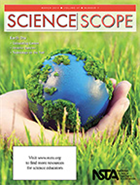Earth Day
By Mary Bigelow
Posted on 2014-03-21
 “Think globally, act locally” is a phrase we hear, and for younger students, thinking locally is important, too. Earth Day is celebrated on April 22, but the activities and investigations described in this month’s featured articles go beyond a single day and encourage students and teachers to consider what happens in their own lives and backyards or neighborhoods.
“Think globally, act locally” is a phrase we hear, and for younger students, thinking locally is important, too. Earth Day is celebrated on April 22, but the activities and investigations described in this month’s featured articles go beyond a single day and encourage students and teachers to consider what happens in their own lives and backyards or neighborhoods.
According to the authors of How Low Can You Go? Interdisciplinary Student-Impact Investigations for Environmental Awareness and Sustainability, students may find it difficult to comprehend global sustainability issues. But younger students can understand local issues and how they affect themselves and their families. In this set of activities, students investigate and analyze their own consumption habits. For example, students study the amount of packaging used in food products, where the ingredients come from, and how food gets from the growers/producers to their homes. An activity on waste generation and landfills has students looking at the trash they produce and how this could be minimized. There are suggestions for other activities on consumer habits, too. [SciLinks: Sustainability, Sustainable Development]
What is the value of live trees versus cutting them down for products we desire? The Value of a Tree: Comparing Carbon Sequestration to Forest Products addresses this question. The students determined their own carbon footprint and calculated how much jet fuel (in the form of biofuel) can be obtained from a tree and compared it to the amount of carbon in the tree if it were left standing. The authors include a pre-post assessment and a student activity sheet, as well as several charts of information and options for alternative activities if the school campus does not include trees. [SciLinks: Forests, Renewable Resources]
Invading the Curriculum: Incorporating Service Learning in the Local Community to Enhance Student Engagement focuses on how the topics of biodiversity and invasive ecology can be combined with service learning to engage students in a local effort. The project was designed to connect the school’s curriculum to local environmental issues. Using a service learning model (described in the article), students and teachers worked with experts in their community to do a biodiversity assessment of their school property and the impact of invasive species. The culminating activity was the design of a native garden. [SciLinks: Invasive Species, Biodiversity]
Are you looking for ways to incorporate engineering activities in science classes? Greenhouse Design: An Engineering Unit lists the components of a good engineering unit. Students were given a challenge to design a greenhouse for a particular region. (The article uses the Northern Territory of Australia, but the authors note that the activity could be modified to use anywhere.) Students researched the abiotic factors in their region and determined which type of plants could be grown. They then developed a design and a budget proposal and built a prototype. The article has photos of these along with a rubric and a unit overview of the time required.
During this time of the year, many classes go outside on field trips. Rather than student doing the ubiquitous scavenger hunt, Get Your Students Outside with Technology describes students created an interpretive trail (even if your school does not have a forested campus, a local park could be used with permission). For points of interest, students described them with text, images, or videos, posting their descriptions in a class Google Map and creating a summary for a trail map. They created QR codes to access the information and made signposts with the codes for users of the trail. The author has many suggestions for making this a do-able project with middle-schoolers.
UV or Not UV? That is a question for your sunglasses takes students beyond wearing sunglasses as fashion statements. In this 5E lesson, students test lenses for their ability to filter UV light using UV-sensitive beads. The article has background information on the history of sunglasses and a student activity sheet. I could see how students would find this interesting at this time of the year. [SciLinks: UV Index, Sun Safety]
Disclaimer: The views expressed in this blog post are those of the author(s) and do not necessarily reflect the official position of the National Science Teaching Association (NSTA).


